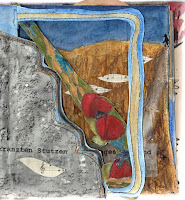| Page 19-20 | “look at the moon, large in the east” |
| For help with the pop-up moon I turned again to Robert Sabuda’s wonderful homepage http://wp.robertsabuda.com. I painted the moon with watercolours on watercolour paper. It rises beautifully! The idea came from a detail of Veit Stoß’ wooden sculpture “Englischer Gruss” (1518 in the church of St. Lorenz in Nuremberg). I have had the postcard below for at least sixteen years. |
|
The sky is painted with gouache and gold ink, ground and boots with Neocolor II and watercolour. | |
|
| Left: Practice painting and construction detail in my sketchbook. The design of the fastening piece ensures that the moon rises slightly from the side, which looks very well. |
| Overleaf backsame procedure as the front, with Palmström’s last bits of singing | |
Does the work fulfil my own expectations?
Yes, I am quite satisfied with the result, and surprised at what emerged. Once I had started on the book I realized with amazement how much material I had gathered during the module, and it was a wonderful experience to draw from this fund and let myself be pushed along by ideas emerging from it. There have been many more drawings and paintings and ideas clamouring to get in. As it is, I think the book is rather packed already (too full perhaps).
Did I develop my ideas fully?
I find it difficult to say that, as there always seems to be a step more ahead, and when do you stop? Still I think that I went farther than I had expected, and new ideas and solutions turned up.
Have I used materials and methods which enable me to produce something exciting?
I am happy that I could include stitching both by hand and by machine, and I feel that this adds interest to the book. It is all in all a very textured item, starting with the woven and stitched pages, gesso or not, a variety of papers and colours, which have all their own properties, from smooth watercolour to pastel and gouache flaking from a smooth paper, and not least the shoelaces. The pop-up parts were a lot of fun, once I had found out how to do them, and I think they fit very well into the book, especially the moon.
If I had to do it again, what changes would I make?
With the experience gathered in this process, I think I would try to develop the drawing process further towards a freer approach, as I started to do with the overleaf pages, my very last step. I would also chose a book with more pages, just to have more space between the covers. The finished pages tend to become thicker and thicker.
Having taken so long I have learned LOTS about ways to sabotage my creative process, beginning with putting work off because I felt too tired or washed out to blocking my thoughts by listening to audiobooks (an addiction) instead of classical music, which keeps my mind free. I have also learned LOTS about the value of experiment and exploration. And: I feel I can draw poppies, cornflowers, wheat ears and boots in my sleep!
A last point is that I do not think I have used my sketchbook in the best possible way. I still tend to draw, paint or write chronologically. It would have been much more helpful if I had collected material relating to one idea in one section for further reference. I will keep that in mind for future work.
Authentication
This is me looking startled, and painting flowers on the gun shape for page 16/17.
|
|
|
| The photograph was taken by my friend Karin Alfter. | I will give contact details in my email. |
Cost: approx. 20 € (price for book, a bottle of glue, cartridges for the printer, use of papers and colours from my stock)
Storage:
|
| I set aside this A3 sized box for storing source material. |
|
| Material was collected in transparent document pouches. |
|
| Separate folder for drawings and art work I considered finished. |
Apart from taking care with the cutting knife there were no special health and safety issues.
____________________________________________________________________________
This concludes my work for chapter 10, and Module 4 of “Creative Sketchbooks”.
Thank you so much, Lizzy, for your cheerful support and advice! Thank you, Andrea and Alfred, for lending me shoes and gun!
I will be back for Module 5.




























Keine Kommentare:
Kommentar veröffentlichen